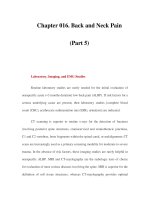Chapter 084. Head and Neck Cancer (Part 1) pps
Bạn đang xem bản rút gọn của tài liệu. Xem và tải ngay bản đầy đủ của tài liệu tại đây (45.25 KB, 5 trang )
Chapter 084. Head and Neck Cancer
(Part 1)
Harrison's Internal Medicine > Chapter 84. Head and Neck Cancer
Head and Neck Cancer: Introduction
Epithelial carcinomas of the head and neck arise from the mucosal surfaces
in the head and neck area and typically are squamous cell in origin. This category
includes tumors of the paranasal sinuses, the oral cavity, and the nasopharynx,
oropharynx, hypopharynx, and larynx. Tumors of the salivary glands differ from
the more common carcinomas of the head and neck in etiology, histopathology,
clinical presentation, and therapy. Thyroid malignancies are described in Chap.
335.
Incidence and Epidemiology
The number of new cases of head and neck cancers in the United States was
40,500 in 2006, accounting for about 3% of adult malignancies. The worldwide
incidence exceeds half a million cases annually. In North America and Europe, the
tumors usually arise from the oral cavity, oropharynx, or larynx, whereas
nasopharyngeal cancer is more common in the Mediterranean countries and in the
Far East.
Etiology and Genetics
Alcohol and tobacco use are the most common risk factors for head and
neck cancer in the United States. Smokeless tobacco is an etiologic agent for oral
cancers. Other potential carcinogens include marijuana and occupational
exposures such as nickel refining, exposure to textile fibers, and woodworking.
Dietary factors may contribute. The incidence of head and neck cancer is
highest in people with the lowest consumption of fruits and vegetables. Certain
vitamins, including carotenoids, may be protective if included in a balanced diet.
Supplements of retinoids such as cis-retinoic acid have not been shown to prevent
head and neck cancers (or lung cancer) and may increase the risk in active
smokers.
Some head and neck cancers may have a viral etiology. The DNA of human
papillomavirus (HPV) has been detected in the tissue of oral and tonsil cancers,
and may predispose to oral and tonsillar cancer in the absence of tobacco and
alcohol use. These patients can present at a somewhat younger age. The incidence
of HPV-related head and neck cancer may be increasing. Epstein-Barr virus
(EBV) infection is associated with nasopharyngeal cancer. Nasopharyngeal cancer
occurs endemically in some countries of the Mediterranean and Far East, where
EBV antibody titers can be measured to screen high-risk populations.
Nasopharyngeal cancer has also been associated with consumption of salted fish.
No specific risk factors or environmental carcinogens have been identified
for salivary gland tumors.
Histopathology, Carcinogenesis, and Molecular Biology
Squamous cell head and neck cancers can be divided into well-
differentiated, moderately well-differentiated, and poorly differentiated categories.
Poorly differentiated tumors have a worse prognosis than well-differentiated
tumors. For nasopharyngeal cancers, the less common differentiated squamous
cell carcinoma is distinguished from nonkeratinizing and undifferentiated
carcinoma (lymphoepithelioma) that contains infiltrating lymphocytes.
Salivary gland tumors can arise from the major (parotid, submandibular,
sublingual) or minor salivary glands (located in the submucosa of the upper
aerodigestive tract). Most parotid tumors are benign, but half of submandibular
and sublingual gland tumors and most minor salivary gland tumors are malignant.
Malignant tumors include mucoepidermoid and adenoidcystic carcinomas and
adenocarcinomas.
The mucosal surface of the entire pharynx is exposed to alcohol- and
tobacco-related carcinogens and is at risk for the development of a premalignant or
malignant lesion, such as erythroplakia or leukoplakia (hyperplasia, dysplasia),
that can progress to invasive carcinoma. Alternatively, multiple synchronous or
metachronous cancers can develop. In fact, over time patients with early-stage
head and neck cancer are at greater risk of dying from a second malignancy than
from a recurrence of the primary disease.
Second head and neck malignancies are usually not therapy-induced; they
reflect the exposure of the upper aerodigestive mucosa to the same carcinogens
that caused the first cancer. These second primaries develop in the head and neck
area, the lung, or the esophagus. Rarely, patients can develop a radiation
therapy–induced sarcoma after having undergone prior radiotherapy for a head
and neck cancer.
Chromosomal deletions and other alterations, most frequently involving
chromosomes 3p, 9p, 17p, and 13q, have been identified in both premalignant and
malignant head and neck lesions, as have mutations in tumor suppressor genes,
such as the p53 gene. Amplification of oncogenes is less common, but
overexpression of PRAD-1/bcl-1 (cyclin D1), bcl-2, transforming growth factor β,
and the epidermal growth factor receptor (EGFR) have been described. EGFR
overexpression has been shown to be very common, and its extent seems to be of
prognostic importance.
Resected tumor specimens with histopathologically negative margins
("complete resection") can have residual tumor cells with persistent p53 mutations
at the margins. Thus, a tumor-specific p53 mutation can be detected in some
phenotypically "normal" surgical margins, indicating residual disease. Patients
with such submicroscopic marginal involvement may have a worse prognosis than
patients with truly negative margins.









